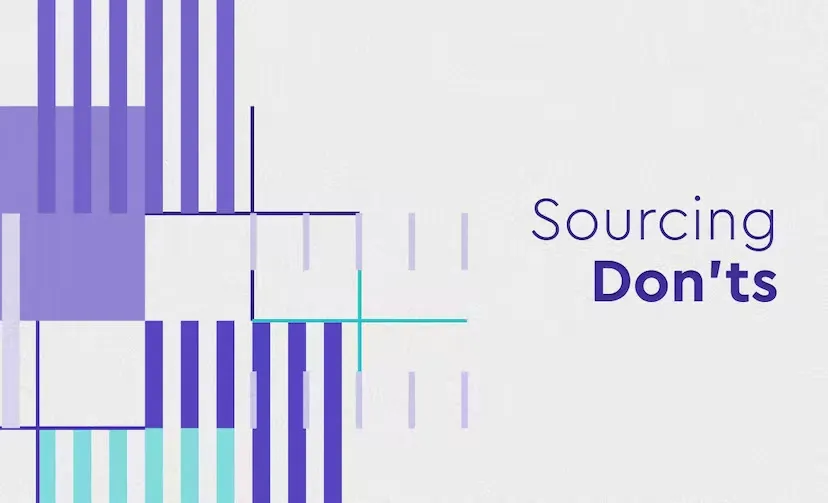· 5 min read
6 Sourcing Don'ts
There’s no way you become a unicorn without fantastic talent, and sourcing a robust candidate pipeline is the first step to getting hiring right.

· 5 min read
There’s no way you become a unicorn without fantastic talent, and sourcing a robust candidate pipeline is the first step to getting hiring right.

If you think about it, your candidate sourcing strategy is one of the make-or-break elements of your startup. There’s no way you become a unicorn without fantastic talent, and sourcing a robust candidate pipeline is the first step to getting hiring right.
That sounds daunting, and sometimes knowing what not to do can be as important 一 if not more important 一 than knowing what to do. So in this piece, we define what candidate sourcing is and then get straight to six things you should not do when it comes to sourcing.
The difference between sourcing and recruiting is often a confusing distinction. Prospect candidate sourcing is the process of searching, finding, and contacting top-tier candidates who match current or forthcoming job requisitions for on demand hiring. Now, sourcing is the initial segment of full-cycle recruiting and so building up a candidate pool and creating an inbound applicant engine doesn’t just happen. Like most things at startups, you’ll probably be in “just-in-time” mode for a while, looking for candidates as soon as a new job description goes live. But over time, the idea is to create a well-oiled sourcing machine.
Sourcing typically uses several strategies but often relies on heavy outreach recruiting and messaging (think cold email and LinkedIn InMail). While cold outreach isn’t everything, it’s often the first step in a larger sourcing strategy. More mature sourcing teams typically use additional recruitment marketing initiatives such as meetups, job fair booths, and webinars.
You want candidates that convert (and those that don’t convert) to speak so highly of your process that it generates new pipe itself. But getting that flywheel going isn’t going to happen if you dot these things in your personalized cold outreach:
Send messages to work emails - Candidates will not want to see recruiting emails in their work inboxes. What if your outreach message pops up as an alert as they are sharing their screen? Guarantee, no one is using their work email for personal reasons! There are plenty of ways to find out someone’s personal email, and candidates are more likely to read your emails if they are coming to the right inbox.
Use the wrong name - Always, always copy/paste the name you see on a person’s application or profile. Nothing turns off a candidate faster than you misspelling their name or sending a wrong email to the wrong person. Hint: also pay attention to whether or not they use a nickname on external-facing materials, like a LinkedIn About section. To make life easier, tools like Talent CRM automate the insertion of candidate names right from their profile (no more human error!).
Source from one location - A recent survey report from Gem indicated that** 40% of LinkedIn users have their InMail muted**. If your only sourcing strategy is to surf LinkedIn and fire off messages, you are setting yourself up for failure. As a best practice, find out where your target candidates congregate. For software engineers this could be places like StackOverflow or Github. For Designers you might try Behance or Dribble. Lastly, be sure to employ a multi-pronged approach and make the most of LinkedIn messages, email, and in-person communication.
**Ask candidates for their resume upfront **- Most people are hesitant to share personal data and update their resume when they don’t even know if the role you’re presenting is a true fit yet. However, you’ve already stalked them on whatever profiles you can find, and you probably have a good sense of their work experience. So explain that you’d like to schedule a screening call and instruct them to send you their resume or upload it to your ATS for the hiring manager to see. Do not pressure them into providing it, this causes a bad candidate experience.
**Fail to follow up **- How many emails have you missed the first time around? If you’re like most people, that number is fairly high. Prospect candidates are busy and forget to respond or accidentally deleted emails, too. Schedule reminders to follow up at least two times for stellar candidates. A single follow-up results in nearly a 2x increase in your response rate.
Make it hard to apply - Persuading a prospect candidate to apply for a role is a big deal 一 don’t squander it with an arduous application process. Limit the number of clicks it takes to apply. Make sure the application page UI looks professional on mobile devices and on a desktop. Don’t include any unnecessary questions that can slow down the process. Remember, you’re trying to engineer an exceptional candidate experience.
Instituting a solid sourcing strategy is easier said than done. Startups don’t have cold outreach templates, referral programs, or passive candidates to draw from out of the gates. They have to start from scratch which is how to grow a recruitment business. However, as the pipeline builds and more positions open up, candidate recycling is a very strategic method to keep in your back pocket. Knowing what not to do is certainly helpful, but knowing how to craft the perfect outreach template, what metrics to monitor, and where ideal candidates hang out will set you up for ultimate success.
Establishing a hiring engine starts with building and automating your candidate pipeline. Luckily, we know the best tool for that. Talent CRM leverages prospect history to understand candidate outreach and engagement. Not only that, Talent CRM helps you personalize your messaging, syncs to your inbox, and integrates with CRMs and ATS systems to keep you on track. Start avoiding these 6 don’ts by signing up for a free trial of Talent CRM today.